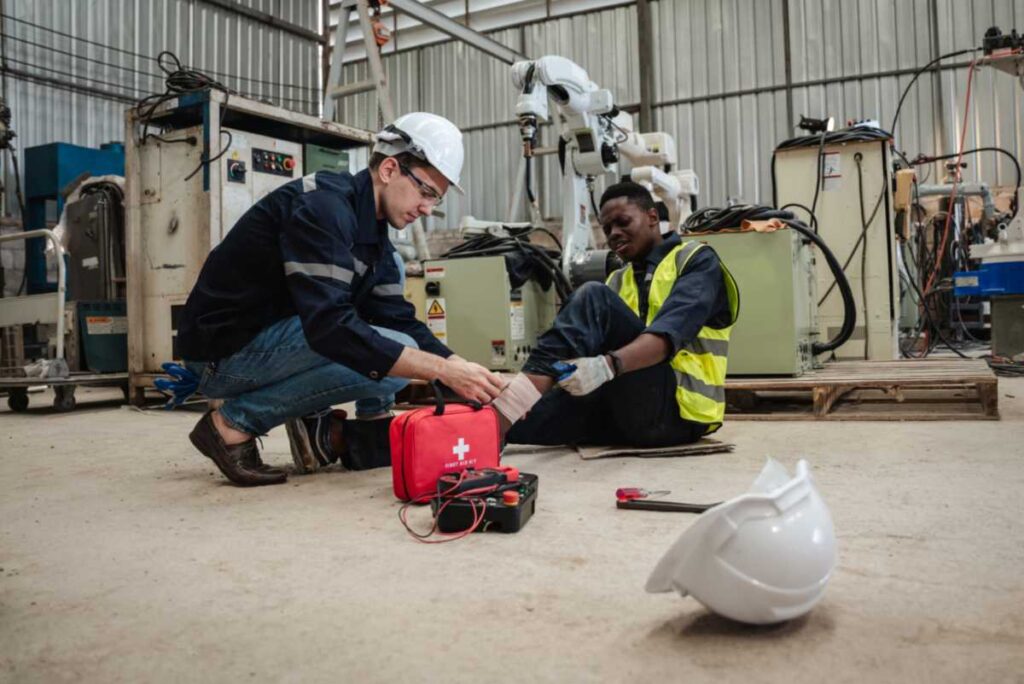Why Is First Aid Important?
What Is the Importance of First Aid?
First aid training protects workers and saves lives during emergencies. Industrial environments present unique risks that require immediate response capabilities. When accidents occur, the first few minutes determine outcomes. Proper first aid knowledge transforms bystanders into life-savers. First aid is crucial to stabilizing conditions in an emergency until professional help arrives. EnviroBEE knows that understanding why first aid is important helps companies build a strong safety culture. Well-trained teams prevent minor injuries from becoming major incidents. They respond effectively to cardiac events, severe bleeding, and respiratory emergencies. This preparedness reduces liability, improves worker confidence, and demonstrates care for employee well-being.

First Aid Requirements for Industrial Workplaces
Providing first aid training in industrial workplaces is essential for safety and compliance. OSHA’s 29 CFR 1910.151(b) requires trained staff and proper supplies when medical facilities aren’t nearby. A strong first aid program ensures quick responses during emergencies and creates a safer environment for employees. Having this training means benefits such as:
- Trained, On-Hand Responders: Employees with first aid training can manage emergencies confidently and stabilize situations until professional help arrives.
- Stocked Kits for Fast Response: Well-maintained first aid kits keep essential supplies accessible at all times. This is key to reducing delays in getting fast care for injuries.
- Compliance Assurance: Meeting OSHA requirements avoids penalties and demonstrates a commitment to workplace safety.
- Fewer Incidents: Effective programs reduce lost-time injuries and lower compensation claims.
- Employee Security: Workers feel supported knowing help is available in critical moments.
Essential First Aid Techniques for Workplace Safety
Knowing basic first aid can save lives and reduce injuries in high-risk workplaces. Quick, effective responses to emergencies protect workers and minimize harm. The key first aid techniques every industrial worker should know:
- CPR: Keeps blood flowing to vital organs during cardiac arrest until help arrives. Workers trained in CPR can double survival rates.
- Wound Care: This stops bleeding and prevents infection from cuts or punctures. For best results, use direct pressure, elevation, and sterile dressings.
- Choking Response: Clears blocked airways caused by dust or debris. The Heimlich maneuver can save lives during airway emergencies.
- Burn Treatment: Immediately cool burns with clean water and apply sterile bandages. Chemical burns require specific neutralization steps to prevent further damage.
Building Safety Culture Through First Aid Training
Regular training sessions reinforce proper techniques and build muscle memory. Workers practice scenarios specific to their industrial environment. This preparation reduces panic and improves response times during actual emergencies. Emergency drills test communication systems and evacuation procedures. Teams learn to coordinate first aid response with facility protocols. Practice identifies weaknesses in emergency plans and allows for continuous improvement. How important first aid in our daily living is becomes evident when considering workplace accidents. Trained responders provide immediate care while others clear pathways for emergency vehicles. This coordinated approach maximizes chances of positive outcomes.
Why Is Having Knowledge and Skills in First Aid Important?
First aid knowledge equips individuals to act quickly and confidently during emergencies. Simple steps in those critical moments can prevent severe outcomes and improve recovery. Here’s how first aid helps on the spot:
- Immediate Action Saves Lives: Knowing how to perform CPR or stop bleeding can stabilize someone until professional help arrives.
- Preventing Complications: Techniques like elevating limbs or clearing airways reduce long-term injury risks.
- Boosts Confidence: Skilled individuals feel prepared to step in and assist, reducing panic in high-pressure situations.
How Important Is First Aid in Our Daily Living?
When people know first aid, their impact goes beyond their workplace. Trained individuals bring valuable skills into their communities, creating safer environments for everyone. Key benefits of first aid knowledge include:
- Support in Public Spaces: Trained individuals can help strangers in emergencies, such as choking or sudden cardiac arrest.
- Empowered Families: Employees carry these skills home with them. These skills can assist loved ones during accidents or minor injuries.
- Stronger Community Networks: Shared knowledge fosters trust and collaboration, improving safety and well-being for everyone nearby.
Partner With EnviroBEE for Life-Saving Training Today
Professional first aid training equips industrial teams with essential emergency response capabilities. EnviroBEE provides comprehensive first aid programs tailored to industrial environments and specific workplace hazards across the Carolinas and Virginia. Our qualified staff delivers hands-on training that builds real-world competence. Investing in first aid training protects your most valuable asset: your people. With our training, you can ensure your team is compliant and ready for any emergency. Contact us today to schedule first aid training sessions for your industrial facility.
